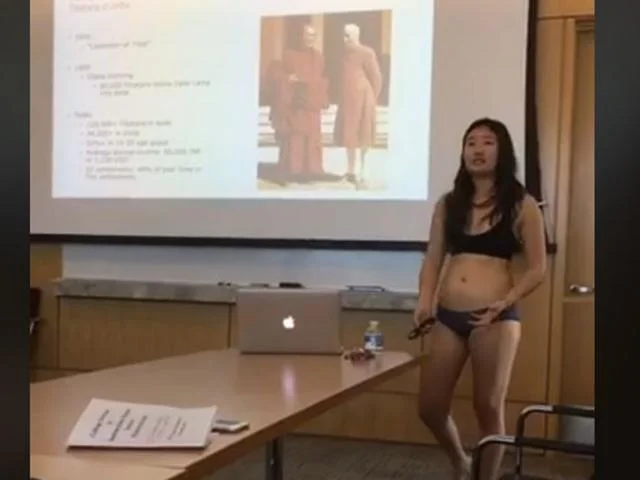Letitia Chai giving her thesis presentation at Cornell. from Facebook
There’s an old saying about how one can overcome anxiety when speaking in public, “Imagine your audience in their underwear.” I speak in public often but have never resorted to this tactic (perhaps because most of my presentations are done in church and such thoughts would be inappropriate.) This last week a student at Cornell University went the opposite direction. She gave her thesis presentation wearing only her underwear and asked the audience to join her.
The story is that Letitia Chai, the aforementioned student, was about to give a practice presentation of her thesis in the class “Acting in Public: Performance in Everyday Life”. As she was preparing to deliver her talk the professor commented on her attire (she was wearing very short cut-off denim shorts) and asked if that was what she was planning on wearing for her final presentation. The question did not go over well.
Ms. Chai was taken aback and offended at the perceived criticism of her appearance. She took particular umbrage at her teacher’s suggestion that her appearance was making a statement that might detract from the points Ms. Chai was trying to make. Ms. Chai stormed out of the class. A few minutes later she returned to the room and took her spot in front of the class, wearing only her bra and underwear. She later wrote how proud she was that she had stood up for “every person who has been asked to change how they look to make other people feel comfortable.”
Her story resonates with me for I had a similar conversation with a female medical student a few years ago. The student, by far one of the best I have ever taught, showed up to the office in a tight fitting blue cotton t-shirt along with white denim pants and a matching blue belt. The outfit was undeniably “cute” but it looked like something a young college student would wear on a date. It was not what would I considered professional attire. I pointed this out to her.
“You are a young woman,” I told her, “and you are asking people to trust you with their lives. Look the part.” I told her it would be easier for people to take her seriously if she was dressed seriously and that when she came to my office to see my patients I wanted her to dress as if she was interviewing for a professional position.
To her credit she received the feedback in the spirit is was given. Each day thereafter she wore either a dress or slacks and blouse. She oozed professionalism and carried herself with class. While nothing about her knowledge or skill set had changed, the perception others had of her did. It was a growth experience for her.
Over the years I have had similar conversations with other students, employees and even my children. My message is always the same. Like it our not, what we wear sends a message. Our jobs get easier when the message sent by our appearance aligns with what we hope to communicate. If we want people to think we are professional, we should dress professionally. As a physician I want to do everything I can to convince people I know what I am talking about, I do not want to give them any reason to dismiss what I say. Unlike Ms. Chai, I intentionally change my look in order to make other people feel comfortable. I do this because they are more important than I am.
This is true in every area of my life. When I give advice to a patient, it is the patient’s understanding that matters. When I deliver a sermon in church, the intent is for the audience to receive what I am saying. When I am called to the hospital to meet with a family about end of life care, it is important they believe I am an expert in the ethical issues we discuss. In each of these settings I choose my wardrobe carefully. I always where a dress shirt and tie in the office, always wear a collared shirt in church and always wear a conservative suit when I meet with families. Communication is never easy; there is no reason to make it more difficult by dressing inappropriately.
It appears this is a life lesson Ms. Chai has yet to learn.
- Bart
Thanks for reading, sharing and commenting. I can be followed on Twitter @bartbarrettmd. Blog subscribers have posts delivered via email, click the button to subscribe




